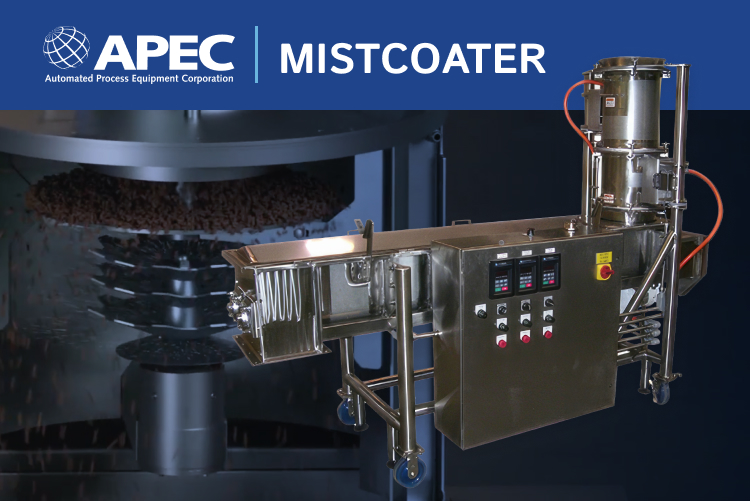
When solid materials mix, a degree of material segregation is inevitable. A variety of processes are used to achieve a predetermined level of uniformity in batch mixing processes, however other processes downstream can cause the materials to separate again. With proper design considerations and awareness of the material segregation physics at work, processes and products can be tested for separation, and product defects can be avoided.
Material Segregation Problems In Batch Mixing Processes
Sifting
How It Works
Scientifically known as granular convection and known in practice as the Brazil nut problem, sifting is one of the most common material segregation problems in batch mixing processes. Sifting occurs mainly through the relationship between the particles’ size and mass; particles significantly larger and more massive (like Brazil nuts) rise to the top of the mixture, and smaller, less massive particles (like cashews) fall between the spaces towards the bottom. It can occur without movement, but movement worsens the problem, since vibration or shaking causes smaller particles to relocate faster into empty spaces. The degree with which this material segregation problem occurs depends on the variation between the particles’ size and mass, and the amount of each.
What You’ll See
Sifting is a material segregation problem impacting many processes. A vibrating conveyor belt can cause sifting, as well as some stirring processes. Even shaking a completed package (like a jar of mixed nuts) can cause this separation.
Angle of Repose
How It Works
The angle of repose material segregation problem in batch mixing processes works similarly to sifting, but operates on a different principle. Instead of sinking to the bottom, smaller, finer particles form a hill when they are poured or dispensed. When thicker, coarser particles reach the hill, they tumble down towards the edges. The materials’ differing angle of repose—the angle at which it will be stable and not tumble down—causes this separation.
What You’ll See
This material segregation problem in batch mixing can be especially difficult. In silos and hoppers it’s often the cause of flow problems like ratholing and bridging. If the coarser particles stick to the sides of the hopper they can get rancid and contaminate the next batch. Since air flows through the coarse and fine materials at different levels when they are dispensed, it can create a pressure differential that can damage a holding unit, such as a silo. Most commonly in batch mixing, the material segregation causes different concentrations of ingredients when the mixture is dispensed from an improperly designed hopper.
Fluidization
How It Works
Fluidization occurs when a mixture is suspended in a gas or liquid. In batch mixing processes, this material segregation problem most commonly occurs in plain old air. When a mixture is aerated (which may occur simply through free falling), the finer, less dense particles retain air and move towards the top of the mixture, while the larger, denser particles which didn’t absorb air sink.
What You’ll See
This material segregation problem in batch mixing commonly occurs in powder ingredients. If the powder does not bind sufficiently to another material, it will separate through fluidization if aerated or allowed to free-fall. With all the powder at the top, the uniformity and product quality can be compromised. Fluidization, combined with the previous two material segregation problems, also poses workplace safety risks from powder explosions and respiratory hazards as large amounts of powders separate into the air.
Trajectory Segregation
How It Works
Unlike the previous three material segregation problems, trajectory segregation occurs through horizontal movement. This occurs by two different principles. In a fluid mixture, trajectory segregation occurs through a relationship between particle size, density, viscosity, and velocity. Particles with the same viscosity and velocity, but different size or density will travel at different rates. This causes the mixture to seperate.
In a solid mixture, trajectory segregation occurs through friction. Finer materials with more surface area and therefore more friction move slower and will deposit closer to the end of the horizontal path. Larger materials with less surface area and less friction move faster and deposit further.
What You’ll See
This material segregation problem in batch mixing processes commonly occurs in ribbon blenders and conveyors or chutes. In ribbon blenders, the particles in a fluid suspension separate in the blender due to their differing size or density. In chutes and conveyors, friction causes the materials to move at different rates, creating a pile of fine materials near the end of the chute and coarse materials further away.
Material Segregation Solutions In Batch Mixing Processes
Ingredient Testing
In order to solve material segregation problems in batch mixing processes, the materials and processes must be well understood. Knowing the particles’ density, size, mass and other properties can help you predict how the materials will segregate. While designing process automation equipment, ask your manufacturer if they will conduct ingredient testing for angle of repose, sifting capacity, and other issues. With this information, your manufacturer can design equipment to prevent material segregation problems in batch mixing processes.
Material Segregation Testing
When testing material segregation in existing batch mixing processes, make sure to test accurately. Remember that material segregation in the end product will also affect any tests on the end product. Use a sample thief or a riffler to get samples that accurately represent the whole, and see where and to what extent problems exist in the process chain. Remember to check the coefficient of variation at different points of the process, not just at the mixer, to see if your downstream process is causing segregation.
Feed Bin Design
Angle of repose problems are most commonly caused by an improperly designed feed bin and hopper. Using a mass flow hopper designed according to the materials’ angle of repose will prevent the mix from dispensing unevenly. In general, an angle of at least 70 degrees is recommended. Hopper inserts or low-traction coatings can also be used.
Mixing And Blending
Mixing and blending processes should be carefully selected and placed. The wrong mixer or blender can actually cause materials to separate through trajectory segregation. If the mixer is placed too early in the process, the materials may simply resegregate downstream. Placing a mixer immediately before dispensing can mitigate segregation effects.
Coating
Many material segregation problems only occur in free-flowing mixtures. Adding a binder can stop problems like sifting, though other problems like sticking and clogging should also be considered.
Agitation
Aeration or vibration can remix some materials, particularly if they are separated in a silo or hopper. With both of these methods, be careful not to introduce sifting or fluidization.
New Materials
More drastic differences between materials cause more drastic material segregation problems in batch mixing processes. If your materials are especially coarse, or a large variation between particle size and density exists, talk with your supplier about material quality. Or, consider additional processing to a diverse material; would adding another process for more material uniformity prevent material segregation problems? Would it be cost-effective?
Material segregation may occur in areas that operators never see. This means you might only see the results in low product quality or contamination. You might also experience repeated processing problems and machine errors due to clogging, flooding, low flow and other issues. If you’ve noticed these issues, assess your batch mixing processes and see where material segregation problems may occur. Once you identify the problem, a simple fix may increase product quality significantly.








2 thoughts on “Solving Material Segregation in Batch Mixing Processes”
Comments are closed.